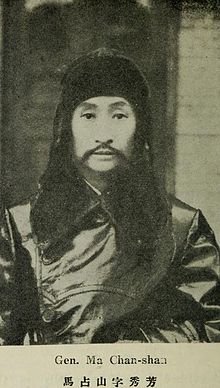Ma Zhanshan 馬占山 | |
|---|---|
 General Ma Zhanshan | |
| Minister of Defense of Manchukuo | |
| In office 9 March 1932 – 7 April 1932 | |
| Preceded by | Position established |
| Succeeded by | Zhang Jinghui |
| Governor of Heilongjiang | |
| In office 1940[1]–1945 | |
| Succeeded by | Han Junjie |
| In office 20 October 1931[2] – 1933 | |
| Preceded by | Wan Fulin |
| Personal details | |
| Born | 30 November 1885 Huaide (Gongzhuling), Jilin, Qing dynasty |
| Died | 29 November 1950 (aged 64) Beijing, People's Republic of China |
| Political party | Kuomintang |
| Relations | Ma Zhiwei (grandson) |
| Military service | |
| Allegiance | |
| Branch/service | Northeast Anti-Japanese National Salvation Army |
| Years of service | 1913–1950 |
| Rank | General |
| Battles/wars | |
Ma Zhanshan[a] (November 30, 1885 – November 29, 1950)[3] was a Chinese general famous for resisting the Japanese invasion of Manchuria. Ma was placed in charge of the Northeastern Army in Heilongjiang Province during the invasion and ignored orders from the central government not to resist the Japanese. He became a national hero in China by fighting the unsuccessful but highly symbolic Jiangqiao campaign against the Kwantung Army's advance into Heilongjiang. After his defeat, he feigned defection to the Japanese and was appointed Minister of War in the new Japanese puppet state of Manchukuo. He then joined and took command of the guerrilla campaign against Japanese occupation, taking with him large amounts of supplies, funds, and military intelligence. Ma Zhanshan rejoined the Northeastern Army after the guerilla movement was largely defeated. He continued to oppose Chiang Kai-shek's policy of non-resistance and supported the Xi'an Incident that forced Chiang to form the Second United Front with the Chinese Communist Party (CCP). He commanded several units in the National Revolutionary Army during the Second Sino-Japanese War while covertly cooperating with the CCP. Ma avoided direct participation in the postwar Chinese Civil War and eventually defected to the Communists, dying a year later in 1950.
- ^ Steen Ammentorp (2000–2009). "The Generals of World War II Generals from China Ma Zhanshan". Retrieved 31 October 2010.
- ^ Hung-mao Tien (1972). Government and politics in Kuomintang China, 1927–1937. Stanford University Press. p. 185. ISBN 0-8047-0812-6. Retrieved 2010-06-28.
- ^ Index Ma-Mam
Cite error: There are <ref group=lower-alpha> tags or {{efn}} templates on this page, but the references will not show without a {{reflist|group=lower-alpha}} template or {{notelist}} template (see the help page).